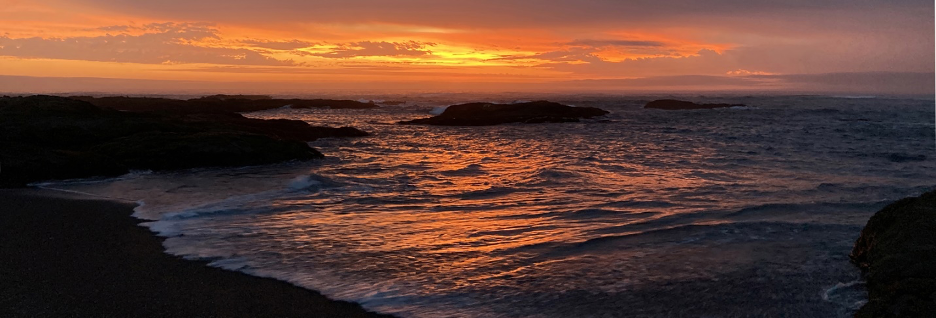Values and Activities
The Institute will promote values and an economy that are sustainable, activities that enrich rather than exhaust and impoverish the land of the County and its people. We will adopt goals that are widely shared on the North Coast: to respect the natural environment; to maintain a population that is diverse in interests, and occupations; to maintain and develop true communities; to have opportunities for meaningful, satisfying work.
The Mendocino Institute will produce educational materials designed to broaden and deepen support for projects that preserve and protect our environment and communities. We will establish connections with environmentalists, educators and community activists in California, the United States and internationally, with the intent to link and exchange information with the broad movement for conservation, preservation and sustainable communities.

The Setting of the Institute
Mendocino County is unique, known for the breathtaking beauty of its coastline, canyons, redwood trees and oak woodlands. Residents and visitors from all over the world love Mendocino. Indeed, it is a national treasure. The County is known not simply for its physical beauty, but also for its communities; all known for their independence and experimentation.
Mendocino County is rural yet complex, by no means monocultural. It offers a space for many lifestyles. It includes fishermen, ex-hippies, fifth-generation residents, timber workers, cooks and cleaners, farmers, painters and musicians.
In the seventies, the County attracted a significant number of people interested in alternative life styles, particularly “hippies,” the back-to-the-land movement and a flowering of communalism. Many of these people still live in the County and add to its distinctive character.
Mendocino County in Transition
Historically, the economy of Mendocino County was based on agriculture and exploitation of natural resources. It depended primarily upon harvesting its forests and the bounty of the sea, but also on grazing, small-scale orchards and farming. A host of rapid changes are making the future of Mendocino County and its residents uncertain at best.
A new economy is emerging. This is the result of the decline of traditional industries, chiefly the timber industry and the fisheries. These industries have given way to tourism and expanding vineyards. Although the forests have been devastated by decades of industrial logging, this practice continues, further threatening habitat and ravaging exhausted forests.
The new economy is partly the result of the arrival of new people and wealth, most often tourists and well-to-do retirees, attracted to the County primarily because of its redwood trees and coastal scenery. Vineyard expansion, which also encourages tourism, is leading to the industrialization of agriculture, while the relentless northward march of urbanization is transforming the inland corridor.
These factors have contributed to restructuring the workforce, replacing older occupations with a workforce comprised of significant numbers of seasonal, low-wage service and agricultural workers, occupations often without the dignity and sense of place that accompanies traditional work. One result is chronic poverty and widening class divisions. Mendocino Village, the jewel of the Coast, glitters, yet Mendocino County continues to be one of the poorest counties in California.

The Growth of Tourism
The growth of tourism is illustrative of the process. The beauty of the coast has attracted tourists, a boom in vacation rentals and a growing number of wealthy retirees. This has led to unprecedented housing development, in particular along the coastal headlands and prairies. It has also led to the proliferation of restaurants, shops and services geared toward this type of population. This in turn has attracted more people and the demand for easier access, chiefly in the form of highways, resulting again in more people. The population of the County is expected to double by 2050. Some consequences need emphasis. First, land values are soaring. Second, while creating employment, neither the tourist industry, personal services, nor agricultural labor have reproduced the rates of pay once offered in the timber industry and the fisheries. One important result is that low-income and affordable housing is disappearing while wages, over-all, are declining.
New workers and their families, often Latino, arrive in Mendocino to work with few services and little support outside their own communities and facing the racism and discrimination that are endemic in California. Other working class families leave the area, or remain marginalized and impoverished. Young people also leave, in particular young families with children. Families are separated, and there is little future in the County for many, regardless of preference or love for the place of their birth. In turn there is a deepening crisis in the schools; they are undermined as enrollments decline, as an aging population withdraws support, and when teachers cannot afford to live in the area. Hence, the number of white-collar workers and professionals declines as well. Finally, that space which allowed for diversity, alternative life styles and experimentation is threatened, along with the County’s rural character, so important in sustaining self-sufficient communities and the possibility of varying patterns of work, family and community.
How the Institute Can Help
These problems – the destruction of the natural environment, the loss of affordable housing, highway construction, population growth, industrial agriculture, declining real wages – differ in degree. They have specific causes and consequences, but they are not simply local problems. They are inextricably connected. Regional, national and even global forces drive them.
Local and ad hoc responses are insufficient in the face of complex challenges of such magnitude. Creative, long range plans and the development of alternative policies are needed, which will require local experience and expertise, in addition to serious, professional research and policy development. Education, democratic debate, and participation within the County and its communities are also required. The goal must be conservation and preservation but also diversity and tolerance, in order to build an economy based on sustainable communities with a quality of life that compliments the natural environment.
The Mendocino Institute will commence research and establish a database for the North Coast on important social and environmental issues. We will strive for objective analysis and avoid one-sided methodologies, as well as any adherence to vested interests. Our goal to develop innovative answers to complex questions by bringing together researchers and community activists from a wide spectrum of experience and academic specialization. We hope to serve the public interest by widely publicizing our findings with the aim of gaining public and governmental support. We will work in partnership with public, private and community agencies and organizations.
Environmental issues of immediate concern include: restoration of the forests, preservation of headlands and the restoration and protection of the watersheds. Social issues include: the cost of land and housing, trends in employment and wages, and the health and education levels of the Coastal population. These, of course, are long-range goals, dependent upon building staff and funding.

Projects
The first project of the Institute was in partnership with the Campaign to Restore Jackson Redwood Forest. The Jackson Demonstration State Forest is 50,000 acres of publicly owned redwood timberland, running west from Willits nearly to the sea at Mendocino and Fort Bragg. The Forest joins the Russian Gulch State Park and the Jug Handle Reserve near the Coast and contains significant portions of the watersheds of the Noyo River, Hare Creek, Caspar Creek, and Big River.
The Mendocino Institute developed educational materials for the campaign, including scientific and economic studies of the impact of restoration on the environment of the Coast, including its watersheds, and the economy of the County. In connection with this, the Institute hosted a conference in November 2000, where these findings will be presented for discussion and debate. These have been published on the internet and as an educational pamphlet to be used by the Campaign and others concerned with restoring the Forest.
The second project of the Institute was a survey of housing development and costs on the North Coast and the impact on these costs on the environment and the coastal communities. The Institute is specifically concerned with such issues as affordable housing and senior housing, as well as housing and facilities for the homeless.
The Institute has supported two important environmental studies directed by Dr. William Russell: Ecological Monitoring of Remnant Coastal Plant Communities and Natural Regeneration Following Timber-Harvest in Coast Redwood Forests in Big River State Park, the latter in partnership with the Save the Redwoods League.
The Institute, in partnership with the Institute for International Studies, the University of California at Berkeley, has initiated a study of the communal movements of the Mendocino Coast in the years 1968 to the present, and thus far three conferences have been held, one in Mendocino in May 2004 and two in Berkeley, December 2004 (Country and City) and March 2006 (West of Eden). One result is the publication of West of Eden, Communes and Utopia in Northern California (PM Press 2011), edited by Michael Watts, Iain Boal, Janferie Stone and Cal Winslow, an anthology on the flowering of communalism in California during the 60s and 70s.
In February, 2011, the Institute organized a conference, The Mendocino Coast: An Eco-communitarian Project, held over three days at the Caspar Community Center. The conference brought authorities on such issues as marine protection, reforestation, affordable housing, eco-tourism and recreation to Mendocino to join local authorities and activists to chart new directions and formulate new visions.
In addition to Conferences, the Institute sponsors an ongoing series of lectures, bringing authorities on important social and environmental issues from universities and institutes throughout the state into conversation with local educators and activists.
The Mendocino Institute sponsors with Retort and KZYX the ongoing radio program, An Antinomian Hour, which broadcast the featured speakers of the Ecology and Community Conference as well as interviews and conversations with ecologists and social and political activists, artists and writers (KZYX.org).
Finally, the Institute is sponsoring a study of the social and environmental history of the Redwood Region, with the purpose of integrating and deepening our knowledge of the history of this important region.
Summary: Alternative Visions and Sustainable Solutions
The purpose of the Mendocino Institute is to explore and propose sustainable alternatives and solutions to present and future problems, with the goal of preserving and enhancing the quality of life in Mendocino County today and for the sake of future generations.
The rapid increase in population in the Bay Area is creating massive pressure on its northern neighbors as is readily apparent in the sprawl of development reaching up the Highway 101 corridor, now on the doorstep of Ukiah. Inevitably, this growth will spill over into the coastal communities.

The Mendocino Institute, then, exists to develop an alternative vision for Mendocino County and the North Coast. We will initiate and support research, planning and activities to this end. We will promote:
- Protection and enhancement of the ecology and the communities of Mendocino County, concentrating on the North Coast based on an economy and development which is sustainable, offers living wages and is rooted in conservation and consistent with the County’s non-urban, natural geography.
- Land use and agriculture that are sustainable and do not damage and impoverish that natural landscape, including its coastline, rivers and streams. Policies that ensure that divested timber lands result in the enrichment of the county, its people and their way of life, as well as with the recreational needs of California and not simply the bottom lines of absentee investors.
- Housing development, which is consistent with traditional patterns, which does not destroy scenic landscapes, and which includes substantial provision for low income and affordable housing.
*Support for high quality public education at a time when federal and state neglect and demographic change threaten the very existence of our schools.
- Collaboration among planners, environmentalists and educators (particularly in the high schools and colleges) with the goal of strengthening environmental values and offering training that gives young people the possibility of viable careers in their own communities. Empowering local communities and organizations with the goal of maintaining and strengthening the health, diversity and tolerance in stable communities.
Serious alternatives and solutions can only be worked out over time, based on research and broad collaboration. A strong point in favor of this project is the existence in Mendocino County of a remarkable history of experimentation and activism upon which to draw.
A Turning Point
We want to make our case to a broader audience as well, for our problems are not simply local issues. There is increasing alarm at the destruction of forests, open space and rural America. There is dissatisfaction with the endless spiral of sprawl—gridlock, ever more highways, endless residential development, identical malls and retail strips with their acres of parking lots. But this will continue unless challenged with positive visions of the future.
There is growing evidence that we are at a turning point – here in Mendocino County, in California, on this planet. Support for protecting our forests, for example, is growing and action limiting logging in the National Forests has proven popular throughout the population. But we will soon have no forests to protect.
Shortsightedness must give way to preservation and creative planning which can produce balanced, sustainable communities that offer positive choices for citizens. There is abundant evidence that this can happen. This is the challenge of the Mendocino Institute.
